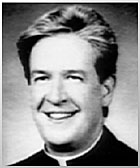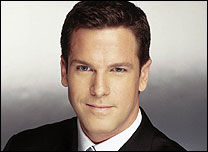A significant portion of sexual abusers of boys in the Catholic Church – I would estimate half – fall into the pattern of multigenerational incest.
One case which I witnessed from various angles over forty years exemplifies this pattern.
In 1964 I entered Calvert Hall College High School in Baltimore, an all-boys’ school. So did Jeff (Jerome) Toohey. He was not in the advanced class, so I did not know him well, but we had many mutual acquaintances.
After high school Toohey entered the seminary for the archdiocese of Baltimore. He studied at St. Mary’s Seminary in Roland Park, near where I live. At that time Richard Sipe, a psychologist and later an expert in clerical sexual abuse, was teaching there. Years later Sipe told me that he witnessed Toohey being seduced by a member of the seminary faculty. The faculty member, whose name Sipe never told me, told Toohey that he had to get in touch with his sexuality etc. Toohey succumbed.
Jerome F. Toohey
Toohey was ordained and eventually was appointed chaplain of Calvert Hall College High School and moderator of the swim team. Toohey’s proclivities were suspected by his former classmates, and there were Calvert Hall yearbooks showing Toohey with the Speedo-clad members of the swim team, annotated with hilarious and obscene comments. (Toohey was also a chaplain to the deaf, who are prime targets of abuse, for obvious reasons – I had cases involving them.)
In the late 1980s or early 1990s, I attended a lecture by Raymond Brown in the chapel at St. Mary’s Seminary. Behind me were sitting a faculty member and a Presbyterian ministress from Govans Presbyterian. She said that she wanted to study Celtic Spirituality, and did they have anyone on the faculty who knew about that. Yes, replied the faculty member, we had a priest who knows about that, but he insisted on sleeping with students and flaunting it too openly. He was sent to a rural parish in western Pennsylvania to cool off, but he would be back.
Around that time a friend of mine, another former Calvert Hall student, was working in an office and met a single mother. They talked, and it turned out that she had a son in Calvert Hall. She said that the chaplain there, Father Toohey, was concerned that her son lacked a male role model and that the son should come to live with him. My friend said, do not ask questions, but under no circumstances allow your son to live with Toohey. The mother said that the proposal had made her uncomfortable.
In early 1993 Michael Goles publicly accused the popular Father Toohey of having abused him at Calvert Hall; Goles was roundly attacked by the Calvert Hall community and the Catholic laity. A parishioner of St. John’s, Long Green, Bill Loeffler, said “This is a lie…. The real victim is Father Jeff because he will never recover from this.”
Then, in 2004, Michael Goles, who remained troubled and unvindicated, got a phone call from someone who had just come forward with similar allegations. The second man, CNN Headline News anchor Thomas Roberts, was also a Toohey victim. He was believed.
In 2006 Toohey pleaded guilty to abusing Roberts and was sentenced to five years in prison, but served less than 10 months before being released into home detention.
Thomas Roberts
In 2007 Thomas Robert told his story:
I became a victim of sexual abuse at the age of 14; the abuse lasted three years. It took me nearly 20 years to gather the strength to help put my abuser behind bars. Now, a year after “justice” was done, I am ready to tell my story publicly in ways I never have before.
My abuser was Father Jeff Toohey, a trusted man of God. He was the equivalent of a religious celebrity in my private all-boys Catholic school in Baltimore, Maryland. Father Jeff was every boy’s friend and mentor. I considered him my mentor as well.
When my parents divorced, I was sent to Father Jeff to help me cope with all the changes. Divorce in the mid-1980s still seemed so foreign. Plus, I was just a kid, and I didn’t know much about divorce. I just knew it sucked.
All I had at that time in my life was my family and school. Those were my constants. But as my family fell apart, so did my life at school. After the abuse began, high school became a prison of shame and lies.
I felt trapped. My parents would be horrified to know their failure at marriage put their son at risk to be sexually abused and that the man abusing me was the high school chaplain and beloved priest.
The school would never believe me, I thought, and I feared I would be expelled if I revealed the abuse. I was 14, with no voice, except the one in my head saying, “You can never tell the truth about what is happening.”
Roughly a month after the abuse started, I attempted to commit suicide. I took a bottle of my mother’s pills. I lined them up one-by-one on my maple dresser. I took them all and lay on my bed hoping to just fade away and die.
My sister, Patsy, came home and found me. It was the day before her 18th birthday. She saved my life that day just by merely coming to my room to say, “Hi.” She saw the pill bottle and went to get ipecac, which made me throw up.
My parents were terribly upset by my actions. Father Jeff was told I tried to kill myself. All agreed I just needed more counseling. Father Jeff’s exact words were, “You have so much to live for.” I felt so cornered, and I had nowhere to go and no one to run to. I just became numb to the abuse.
“This too shall pass” is one of my favorite religious sayings. The abuse did pass, but it left me so insecure about who I was.
When I was in college, another boy, Michael Goles, came forward and reported his abuse at the hands of Father Jeff. I knew I could help Michael if I, too, revealed Father Jeff’s abuse, but out of a feeling of self-preservation, I remained quiet. Michael wasn’t believed, and his case was thrown out of court.
Nearly 20 years after the abuse started, I became strong enough to go back and confront what had happened to me. I was strong enough to tell my family the truth. I was strong enough to report it to the archdiocese. And I was strong enough to call Michael Goles and tell him, “I am sorry,” and that I believe him because it happened to me, too.
Together, we were strong enough to see our abuser finally admit his crimes. Father Jeff was charged with 10 criminal counts of child sexual abuse in relation to my case. He asked for a plea and admitted his guilt in court. He was sentenced to five years in jail but only served 10 months. He was released early to serve eight months in home detention.
This was the pattern that McCarrick followed. He abused seminarians, and then at least one of them abused a boy. When priests initiated seminarians into homosexual activity, the seminarians learned that this was the way that priests were allowed to deal with their sexual desires. They in turn sought out physically mature but emotionally vulnerable teenagers. Some of them entered seminaries, and the pattern continued.
How is it possible to break this pattern of multigenerational incest?
In 2005 Cardinal O’Brien conducted an apostolic visitation of seminaries because of widespread complaints, but it was a joke. He asked, Anything wrong here? No, everyone replied, nothing wrong.
From the toleration that was extended to McCarrick over decades, it is clear that the hierarchy, including perhaps the pope, do not regard the sexual abuse of adult seminarians as a serious matter. Or perhaps McCarrick’s behavior was considered unremarkable and normal.
Even if a seminary is cleaned up, there will always be the possibility of corrupt priests returning to the faculty
If priests have to be educated in seminaries, why does the faculty have to be priests? There are many competent, married laymen and deacons of good character with theology, history, music, and psychology degrees. Priests are ordained to minister to the laity, not to other priests. Laity are the best judges of whether a seminarian is suitable to be a priest, although a bishop must make the decision about ordination and take the ultimate responsibility.
I think this change, which would not, as far as I know, require any change in canon law, would break the cycle of multigenerational abuse. There are other sources of abuse, but I think that the seminaries have been responsible for much, if not most , of the abuse.

